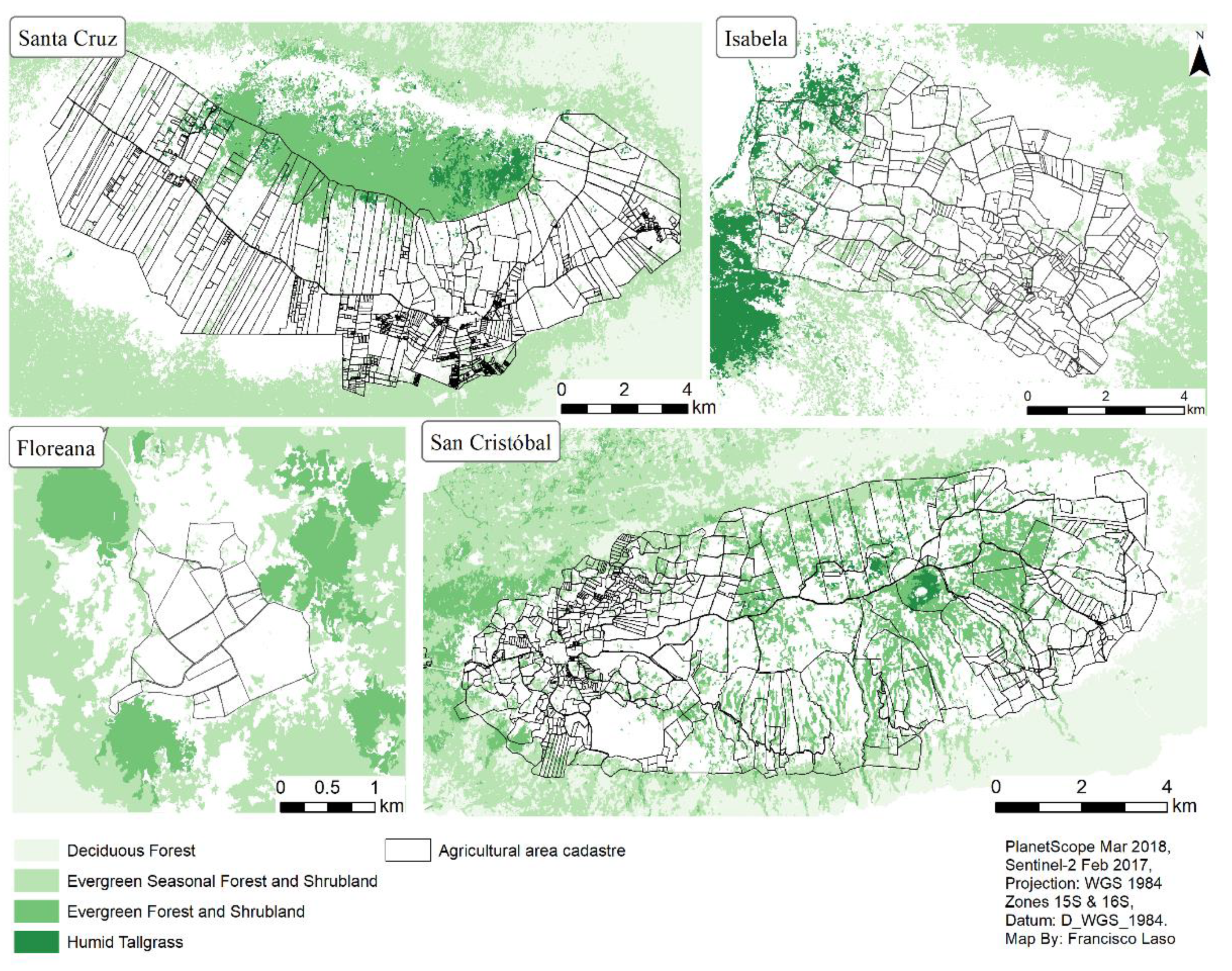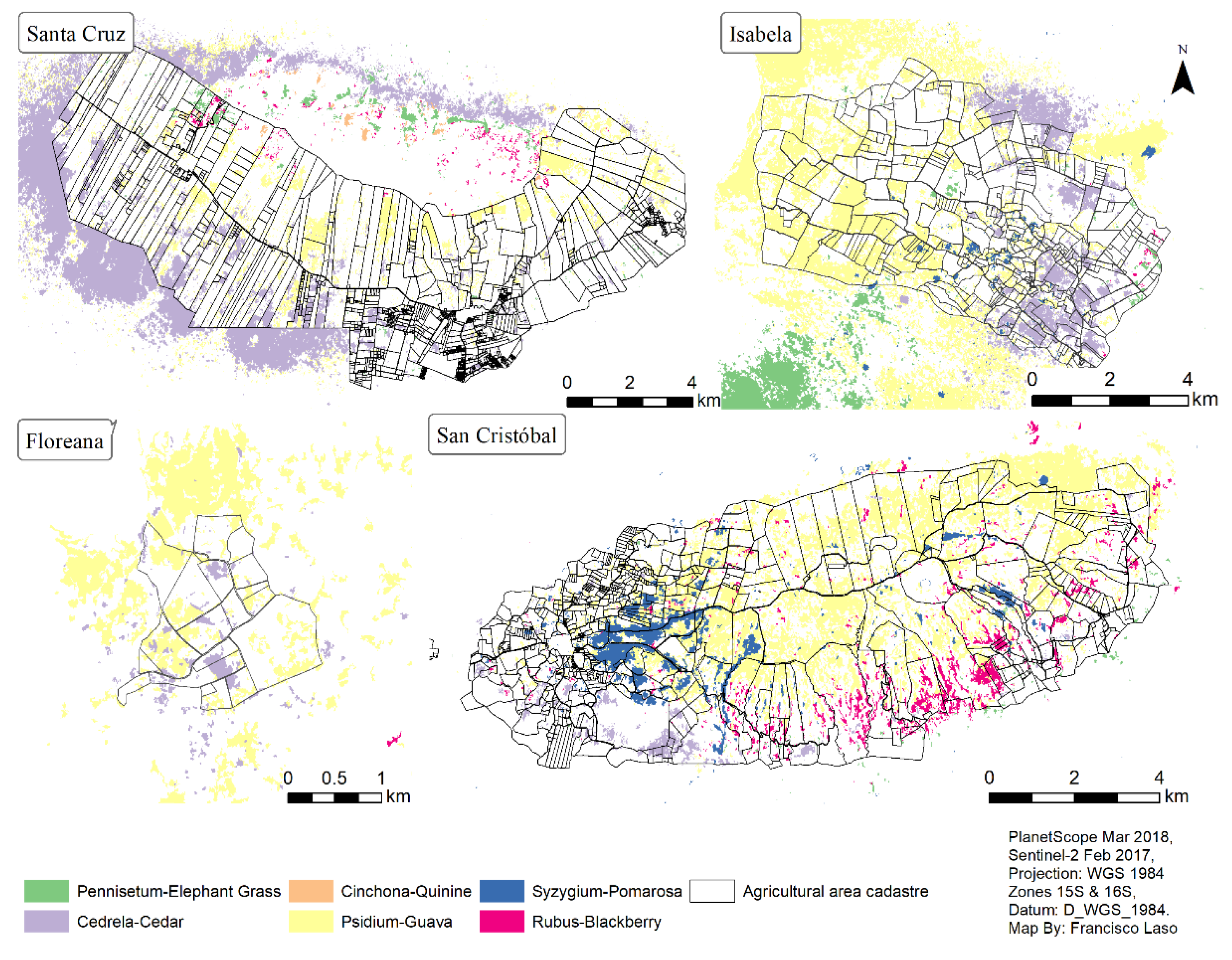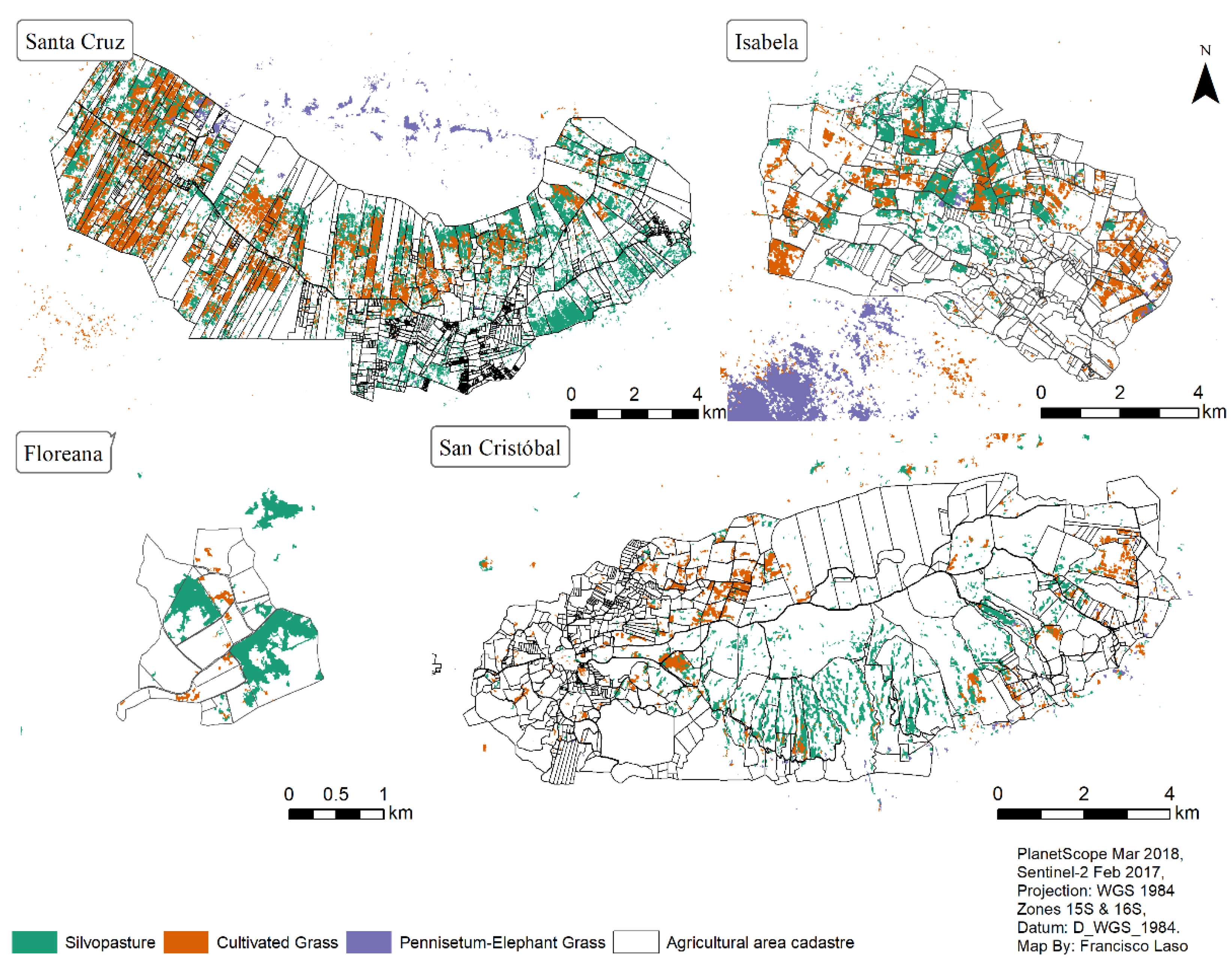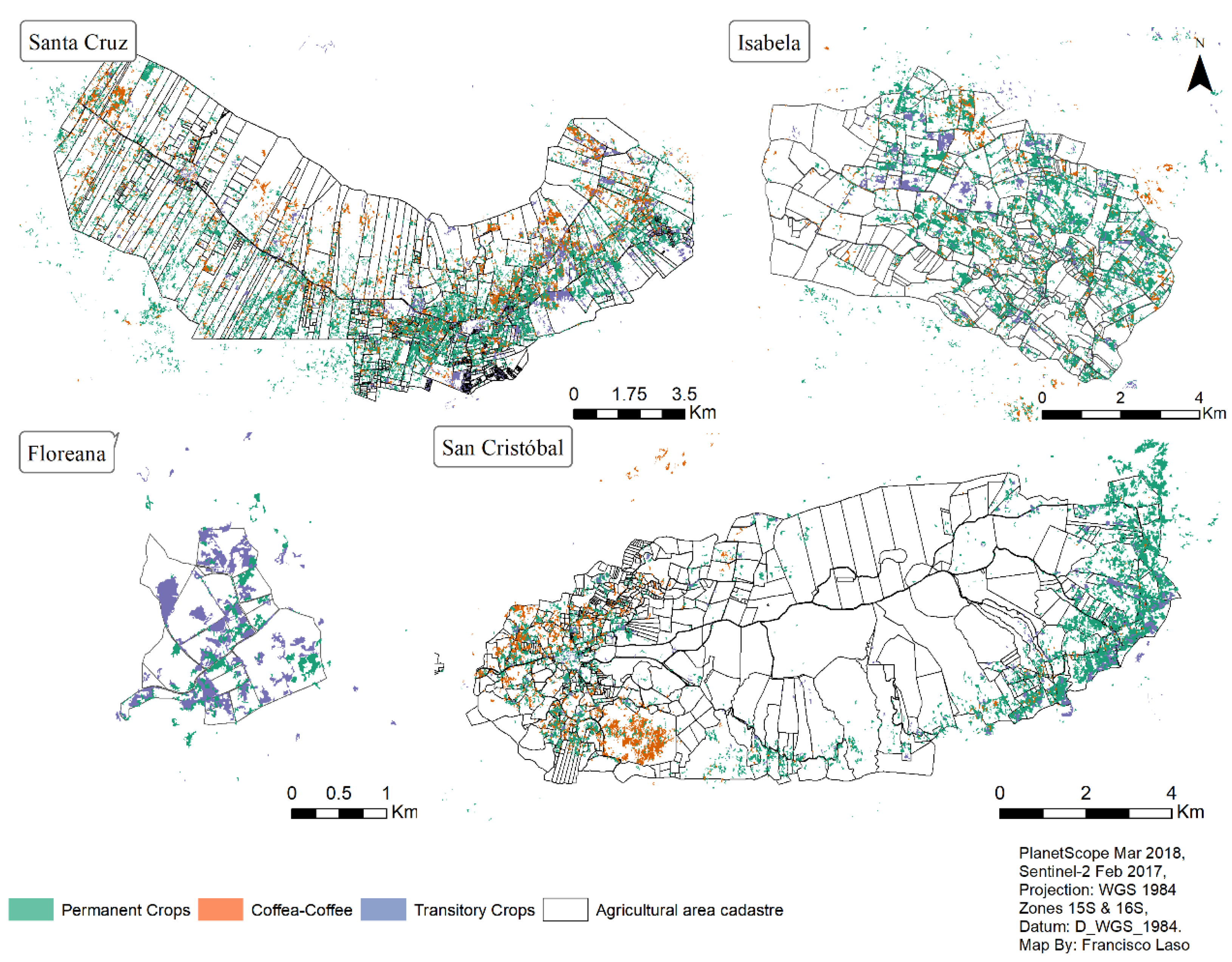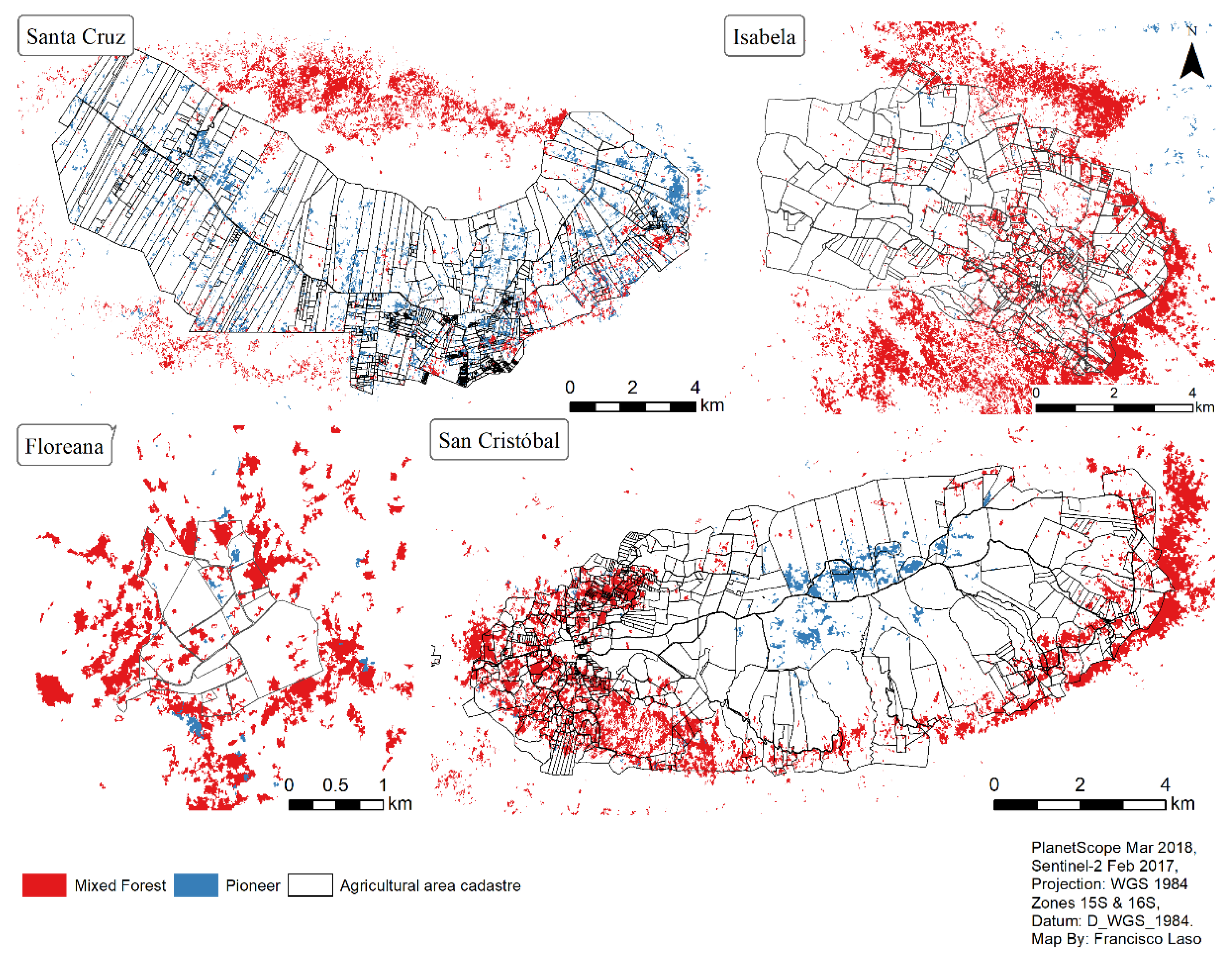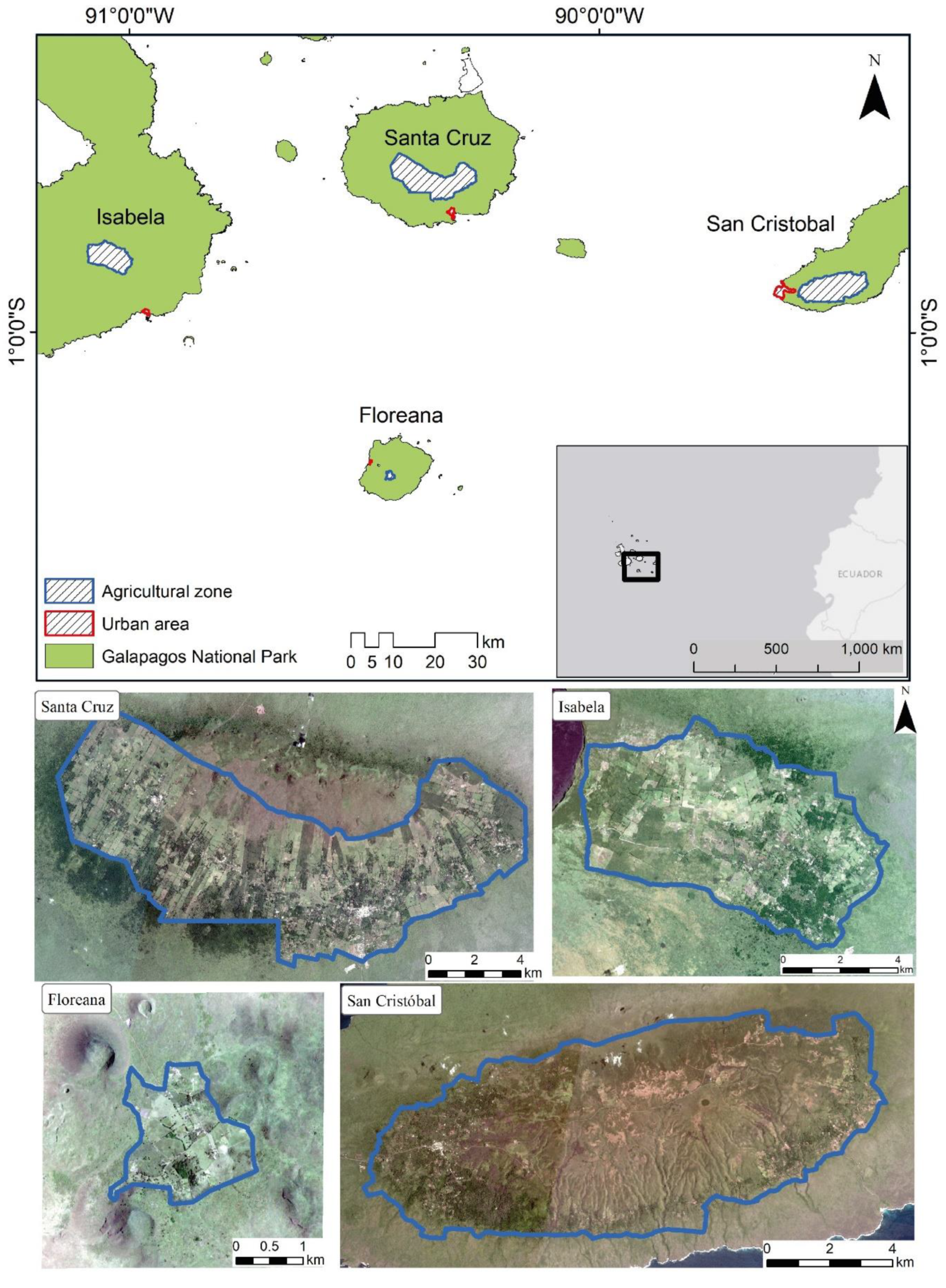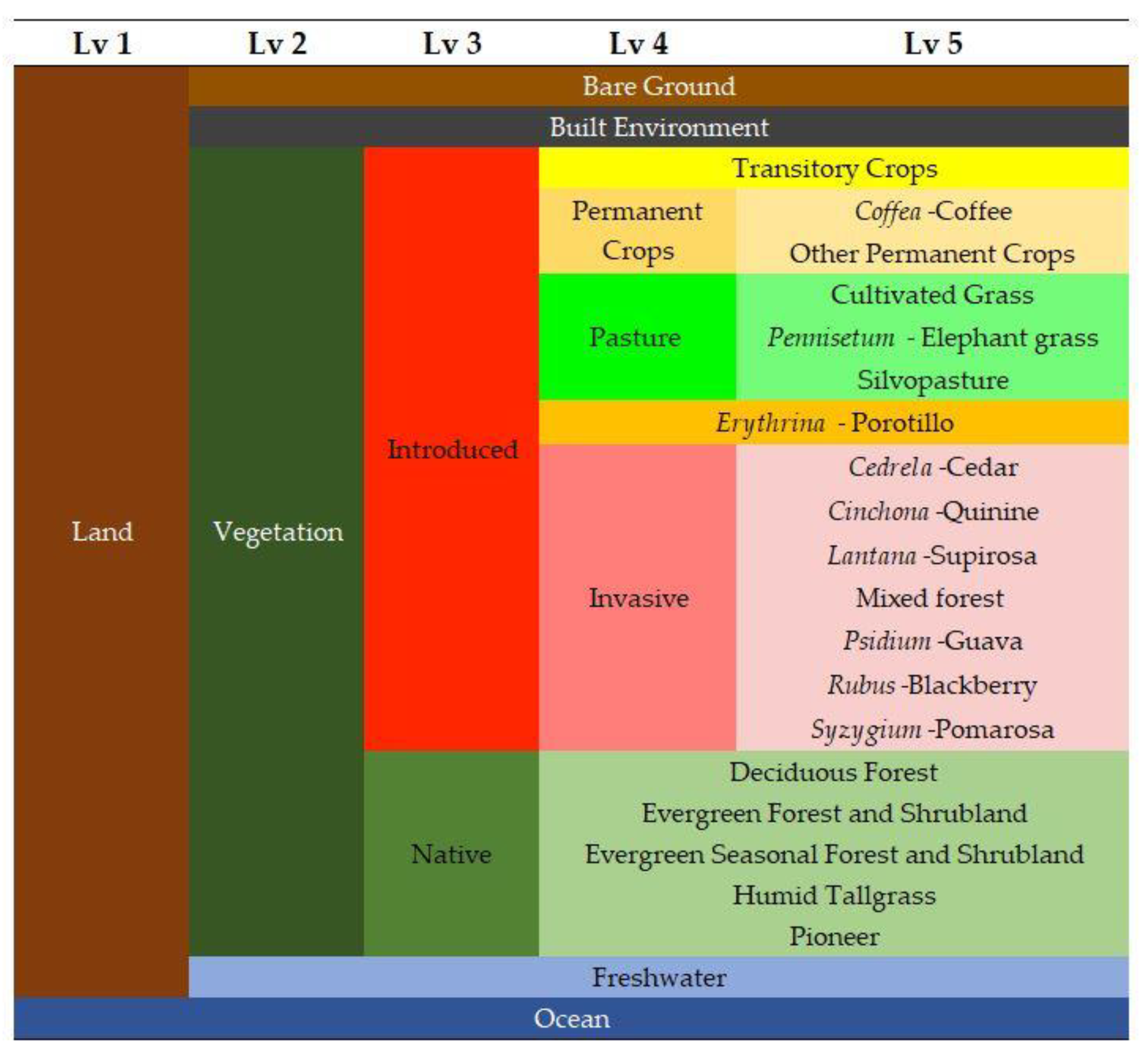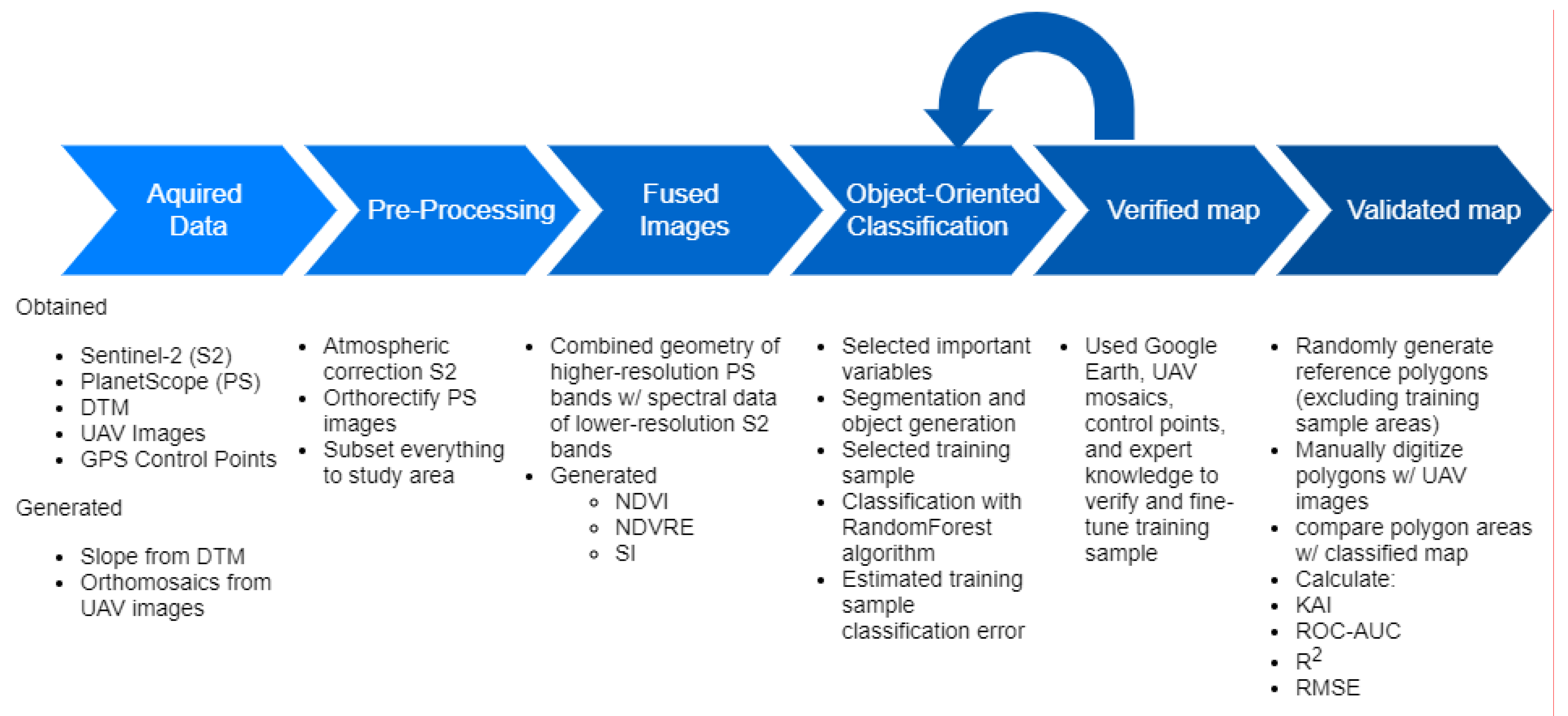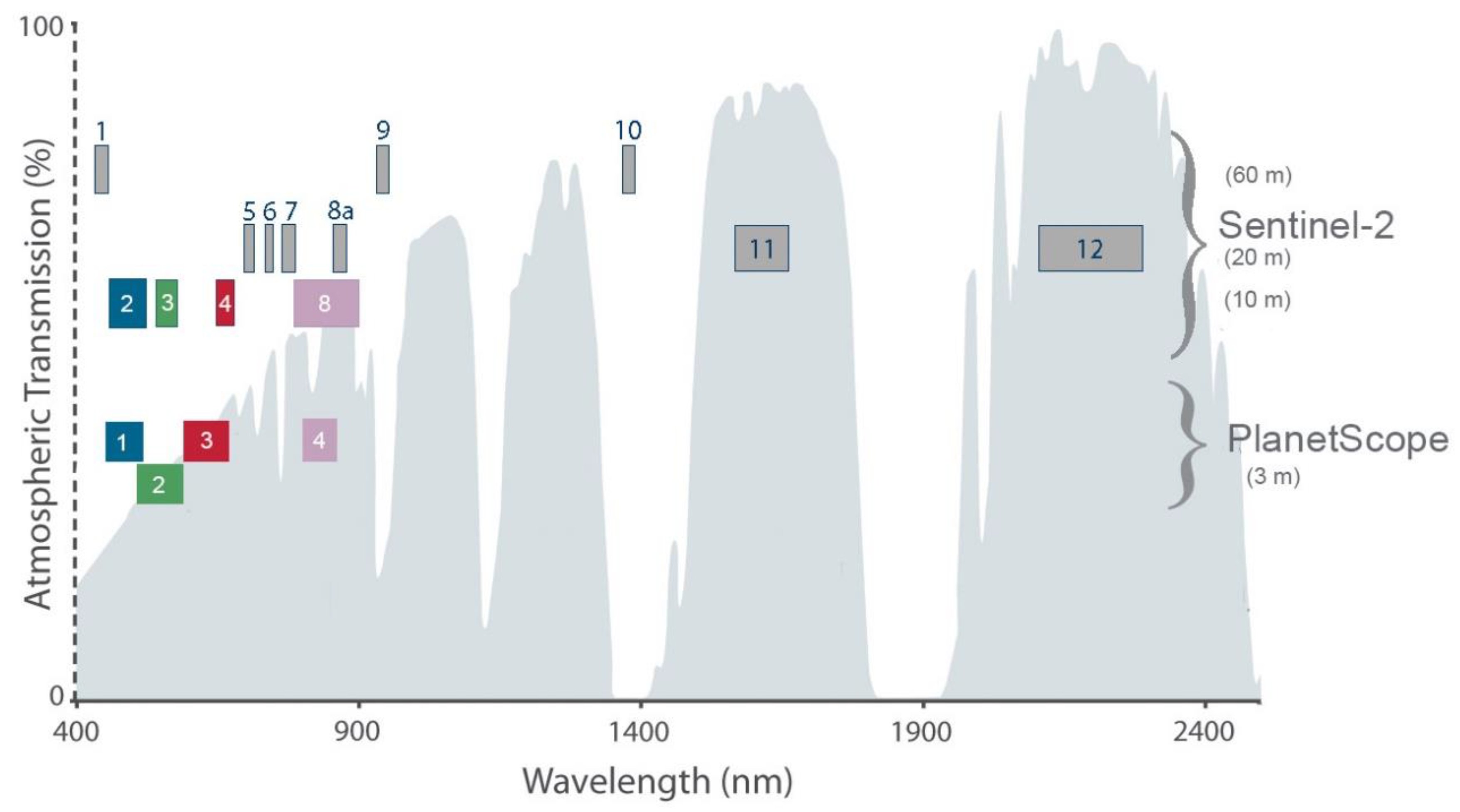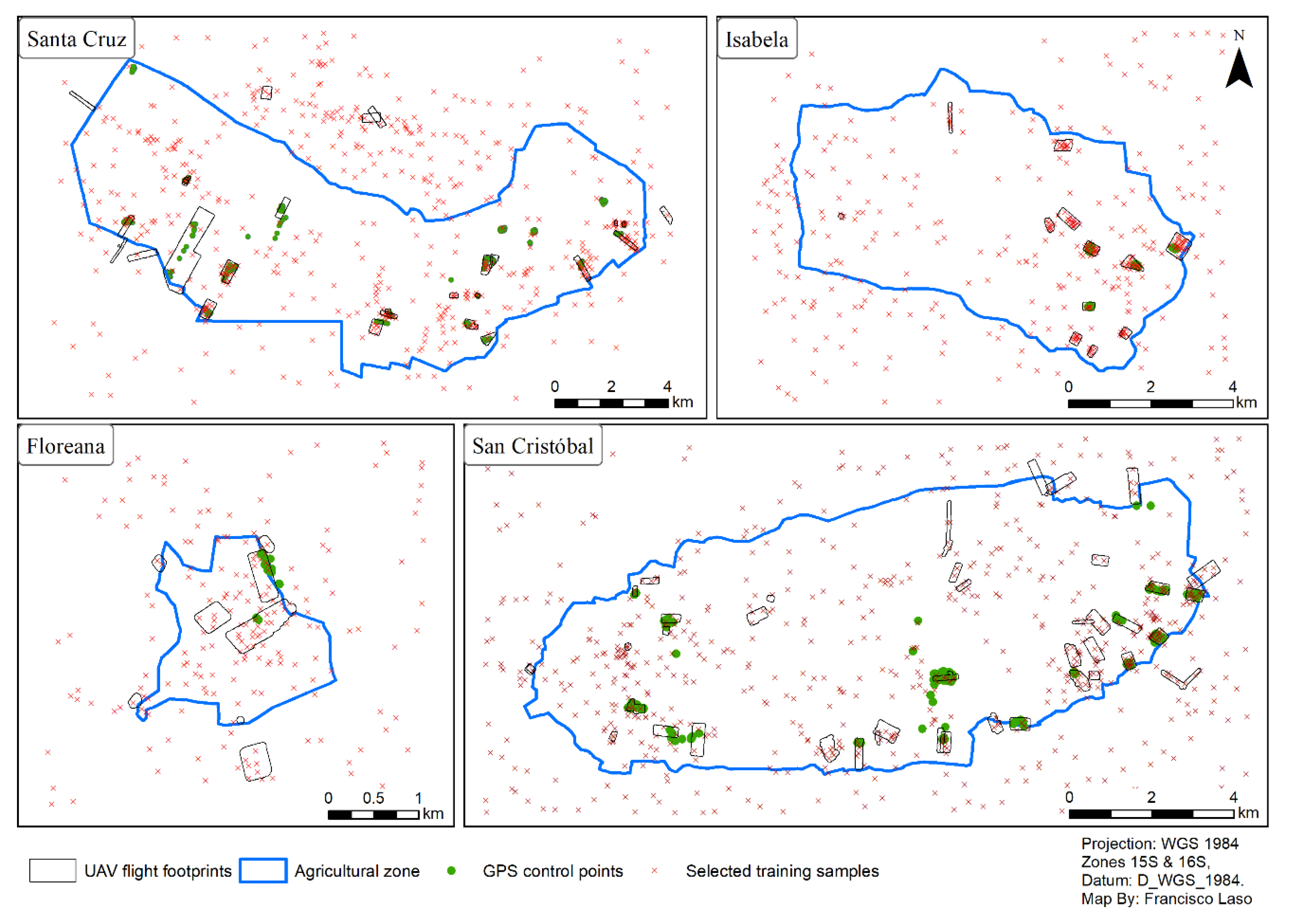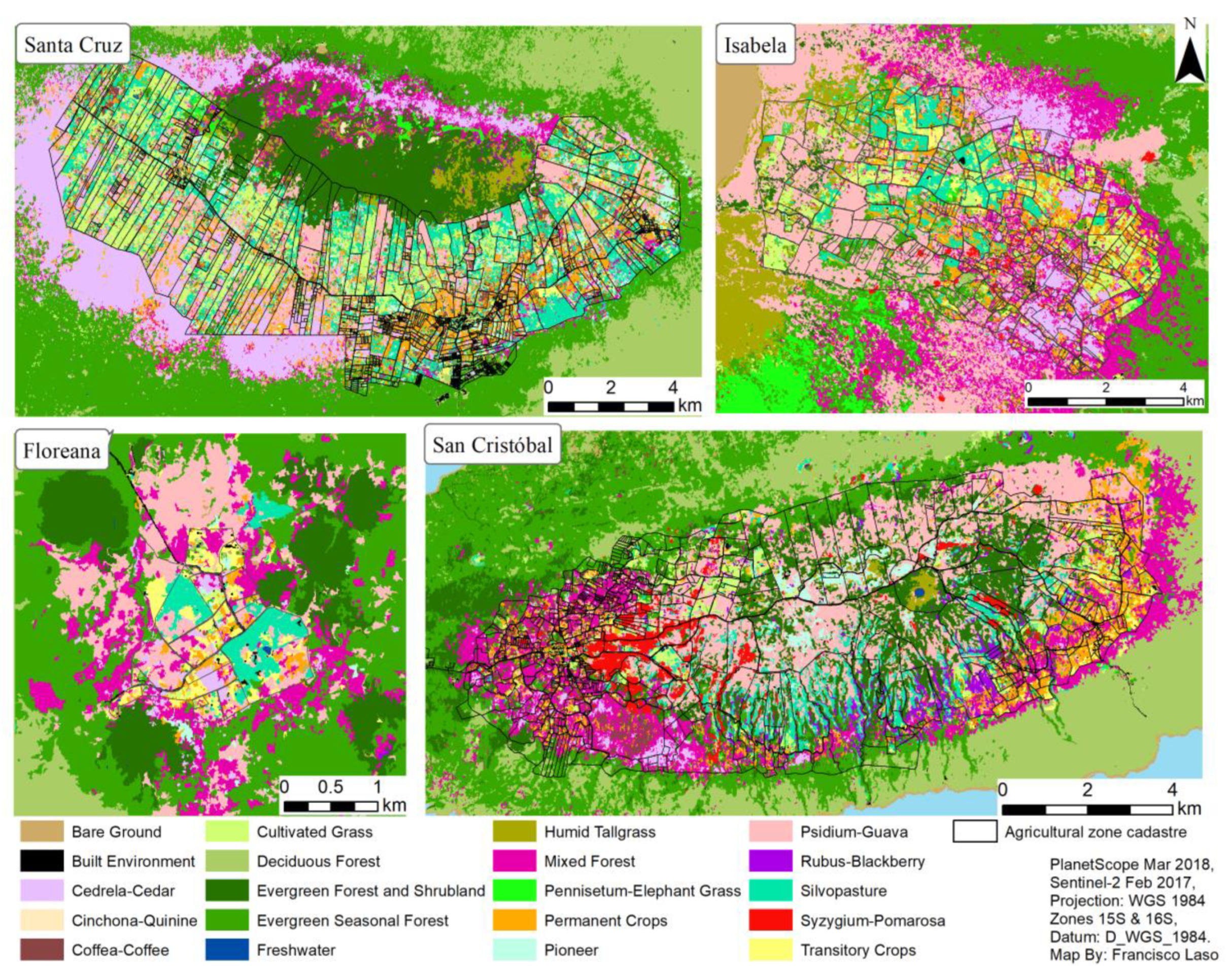Our results suggest that the agricultural zones of the Galapagos and their surrounding areas are incredibly diverse, and different vegetation covers thrive within very close proximity to each other. The complexity of Galapagos agroecosystems presented a challenge to mapping accurately and precisely the main vegetation covers occurring in the highlands of this UNESCO Natural World Heritage Site. These maps are the first attempt, using the latest satellite images available, to integrate vastly different land cover types (e.g., native ecosystems, staple food crops, invasive plant species) within the same decision-making tool, so that concerns of the agricultural and conservation sectors are both represented.
4.1. Methodology and Sources of Error
In this paper, we presented a replicable methodology that uses free and open-source data to monitor land use and land cover change in complex agricultural systems. Agricultural landscapes are a complex patchwork of food crops and other vegetation types, where even small-scale patches of vegetation can be a valuable habitat for animals of different kinds [
82,
83,
84,
85,
86]. Having images with high spatial resolution is crucial for capturing small habitat fragments in the analysis, so methods that use freely-available high-resolution image collections provide a much-needed and inexpensive alternative to purchasing commercial high-resolution data for fine-scale analysis. Mapping an agricultural matrix in high resolution is a challenge because categorically different vegetation types can have similar spectral signatures and be cultivated in proximity with other vegetation types; our object-oriented random forest classification of fused images tackles this challenge by combining data sources with complementing resolutions, taking into account the geometrical properties of landscape features in addition to their reflectance, and by classifying elements with an algorithm that provides reliable results with limited training datasets [
24,
27].
Unfortunately, two land cover types, Lantana and Erythrina, had to be dropped from the final mapping outcomes because we did not have enough reference points to have consistent results during classification. In the case of Erythrina, their proximity to other dense vegetation types, such as permanent crops, Cedrela, and Psidium, was an issue during segmentation. Erythrina trees are usually planted in long stands as living fences are often pruned, so their crowns tend to be relatively small. Therefore, the size of Erythrina stands was insufficient to be adequately captured by the sensors, even at 3 m resolution. The small size and proximity to other vegetation types caused segments to include neighboring pixels of different land cover types and confuse their spectral signatures. Similarly, in the case of Lantana, we did not have enough examples of patches that were large enough to produce a clear spectral response. Additionally, we were limited in our reference data available because some areas lacking information were too remote or of difficult access to reach them by foot to collect GPS control points. On the other hand, weather conditions in the highlands also made image collection with a UAV difficult and sometimes impossible within the timeframe available for fieldwork, as was the case with Isabela’s highest regions within our study area. Therefore, areas that were easier to access or had favorable weather conditions were more represented in our samples.
Additionally, land cover units grouping several species, instead of mapping individual plants, were adopted because these types of general categories are used in policy documents or previous studies. While this makes our results relevant to the intended users of the map (i.e., MAG) and compatible with existing data sources, these categories forced us to group together vegetation types into land cover units that likely had a wide range of spectral signatures. For example, permanent crops, transitory crops, silvopastures, and mixed forest are land cover units that are heterogeneous by definition. For instance, permanent crops are often tree crops, but MAG also includes pineapples in this category since they are technically perennial crops [
40]. Pineapple plantations have a very different spectral signature than tree stands. This inclusion might explain why permanent crops were the most frequently misclassified category (error rate = 28% in Santa Cruz,
Table 9). Similarly, silvopastures are, by definition, a mixture of grass and tree species, both of which could be of different types and have vastly different reflectance, and this probably contributed to their misclassification and high error rate (error rate = 38% in Santa Cruz,
Table 9). Likewise, the mixed forest is defined as an area where invasive species co-dominate with native species [
42]. Given there is a wide range of species, both native and introduced, that could fit that description, it is understandable that humans and computer algorithms could easily misclassify these areas (error rate = 12% in Cristobal and Floreana,
Table 9).
Another challenge to mapping the agricultural area is that this is a very dynamic landscape, and its land cover is always changing. For example, both transitory crops and pioneer vegetation are, by definition, short-lived; farmers harvest transitory crops in less than one year, and succession quickly leads other plants to take over disturbed areas where pioneer plants once thrived. This short life probably confused their classification because the spectral life of specific land cover types is shorter than the two-year timeframe when the different satellite images were collected. Short spectral life might be one of the main reasons why the ‘pioneer’ land cover unit received the lowest R2 score (0.032) during map validation. Despite their ephemeral nature, it was important to include these categories to remain consistent with other data sources and to try to capture a snapshot of current vegetation cover. Furthermore, temporary vegetation covers like ‘pioneer’ or heterogeneous categories like ‘mixed forest’ might signal that these areas are currently in flux, so their presence helps represent the dynamic nature of the agricultural areas.
The landscape and the classification units themselves are not homogenous, so traditional methods for assessing accuracy are limited by the assumption that each area in the map can be unambiguously assigned to a single category, and by expressing classification errors as either “right” or “wrong” without reference to the magnitude of the error [
87]. We initially attempted a point-based accuracy assessment, but this yielded misleadingly low results because GPS control points of individual plant species could not be unequivocally assigned to any one category. Therefore, we opted for a validation method that could accommodate for the landscape’s and our classification scheme’s ambiguity. Expressing our accuracy in terms of percentages and correlations
RMSE and
R2 was more relevant to the users of our classification because we are comparing manually-classified reference polygons with our classification results. However, we included other metrics common in land cover classification and machine learning (KIA, AUC) to reach readers that are more accustomed to them.
Our accuracy assessment results are in a similar range as those from similar object-based land cover classifications [
24,
69]. Our overall KIA value of 0.7 suggests that our classification results are significant and are useful overall. Categories with KIA or AUC values >0.7 correspond to land cover types with a forest or pasture structure (
Table A5). The land covers that were confused most often were bare ground, freshwater, and pioneer cover types. (
Table A5). All three land cover types covered relatively small surface area extensions, so their representation in the validation reference polygons was minimal. This error was especially strong for freshwater (KIA: 0.34, AUC: 0.314) because most visible freshwater occurs in microreservoirs, for which reflectance can change drastically depending on whether or not they are filled. Only one microreservoir fell within the reference polygons for classification. Bare ground (KIA: 0.271, AUC: 0.386) was understandably confused with transitory crops (KIA: 0.446, AUC 0.628) because these areas are usually denuded from other vegetation, and so the spectral response of the bare soil gets confused with that of the crops themselves. Bare ground is also hard to distinguish from built environment (KIA: 0.516, AUC: 0.685) because most roads of the humid highlands remain dirt roads and are not paved yet. Pioneer land cover (KIA: 0.22, AUC: 0.31) was probably confused with several other categories due to their ephemeral nature, as described above. Of the four categories with an AUC value between 0.6 and 0.7, two correspond to land cover types that grow below the forest canopy, such as
Coffea (KIA: 1.927, AUC: 0.676) and
Rubus (KIA:0.417, AUC: 0.603), so it makes sense that their AUC values are not as high, as their spectral signatures can become confused with other vegetation types. The other two categories with an AUC between 0.6 and 0.7 are built environments and transitory crops, which, as mentioned earlier, both become confused with bare ground.
Our results suggest that our classification map likely represents general patterns (large patches) relatively well, especially for categories that had a clear spectral signature and, thus, had a high correlation coefficient as well, such as Cedrela, Pennisetum, and Syzygium. However, the landscape’s heterogeneity means that the map likely becomes more inaccurate as one approaches smaller scales. The fact that the two largest islands, Santa Cruz and San Cristobal, had the highest R2 values (0.83 and 0.7, respectively) might be due to these islands having larger farms with a more regular and well-delimited configuration of their crops than smaller farms from Isabela or Floreana.
While human digitation using high-resolution UAV images would usually have more accurate results than using segments mapped by a computer, the fact that we are using satellite images with a 3 m spatial resolution means that we are within the margin of error for most GPS devices, including our drone. This might cause misalignment with the high-resolution images that we used to obtain the geometry for the reference polygons, thus lowering our accuracy results. Furthermore, given that we used the most homogenous land cover patches visible within our UAV images to help us pick areas to train the algorithm, remaining unused areas of our images were also the most mixed and harder to categorize, which might have affected our accuracy scores as well.
4.2. Vegetation Cover Abundance and Distribution
The fact that the areas surrounding the agricultural areas are GNP lands under conservation means that we expected to find a difference in the vegetation covers within and outside the agricultural areas. As expected, we found that most native vegetation is distributed outside the agricultural zone while invasive species dominate the area within the agricultural areas (
Figure A1 and
Figure A2). However, we also expected to see this pattern due to the long history of agricultural exploitation within the Galapagos. The most aggressive agricultural expansion occurred in San Cristobal from 1879 to 1904 under the rule of Manuel J. Cobos, and this set the tone for commercial development of agriculture in other islands as well. During this time the highlands of San Cristobal were denuded of native vegetation,
P. guajava and avocado trees were brought for pig food,
Sygzygium trees were imported to provide shade for wool sheep, pastures were introduced for extensive cattle grazing to sell cowhides, up to 3000 ha of sugar cane were planted for sugar and liqueur production and export, and over 100,000 coffee plants covered 110 ha of plantation [
88]. In comparison, today, all food crops found in our study area combined barely cover a third of the area that was once covered by sugar cane alone. San Cristobal has the most substantial extensions of
Sygzygium trees in the entire archipelago (374 ha), and
P. guajava covers 23% of the agricultural area. While agricultural activity as a whole has become a fraction of what the island once supported, the area covered by coffee plantations has increased to 191 ha. Given the level of agricultural exploitation, perhaps what is surprising is that San Cristobal also shows the most amount of native vegetation within its agricultural area, which is likely due in part to the work of the GNP reforesting the areas around El Junco with
Miconia robinsoniana.
Other islands followed similar patterns but at different times. Floreana’s first successful inhabitants took residence in the 1930s, and they subsisted by modifying the highlands by knocking down trees, clearing the land, hunting wild cattle, and introducing seeds for crops. For example, the Cruz family, who arrived to Floreana in 1937, dedicated their time to agricultural production and cattle ranching. As their family grew, so did their land and the pastures that covered them; because the population was so small (55 people by 1975), life in Floreana was only assured through agricultural production. By 1965, farmers planted entire hectares of individual transitory crops year-round, and they harvested the fruit from citrus trees that grew wild inside and outside of the agricultural areas [
88]. These patterns are visible in our results, as there are large areas of land dedicated to cattle production and mixed forest surrounds the agricultural area. We also see evidence of more recent events, such as the spread of
R. niveus and
P. guajava across the landscape [
88].
In Isabela, there was a 900 ha farm called “La Hacienda” that was established in 1897 by Carlos Gil Quezada. Quezada’s main economic activity was cattle ranching, and through the 1950s, he captured wild cattle that roamed the pampas of Sierra Negra volcano and exported them to Guayaquil [
88,
89]. Given that La Hacienda is reported to be relatively near the southeastern border of the present-day agricultural zone, it is entirely possible that the pastures visible to the southwest of the agricultural area are the same areas that were used as cattle hunting grounds by Gil Quezada. It would seem unusual that pastures are found outside of the agricultural zone, and the species found in those grasslands remain unconfirmed. We do not have direct verification of the vegetation of this site, but the spectral signature of this region is distinct, and during the development of the land cover map of the GNP [
42], park rangers indicated to the authors that these are
Pennisetum grasslands, so we categorized this region in the same manner. The observed large expansions of invasive species in Isabela are consistent with the recorded process of extensive cattle grazing and subsequent abandoning of lands since the 1980s as meat production became less profitable, leaving Isabela’s last remaining stronghold of agricultural production concentrated in the lowest (easternmost) section of the agricultural zone [
88], which is the same region where transitory and permanent crops can be seen today.
The prevalence of pastures in the agricultural area of Santa Cruz is well reported [
40,
90,
91] and is consistent with our results. The presence of
Cedrela odorata stands in GNP lands (but barely in the agricultural area) makes sense because, since its intentional introduction in the 1940s, the Ministry of the Environment prohibited the exploitation of Cedrela in 2007 due to its threatened status in the continental area. However, by 2009, it allowed the extraction of
C. odorata once again, but only within the agricultural zone [
92]. The distribution of
P. guajava in Santa Cruz is also consistent with our current understanding of how cattle and tortoises are dispersing this invasive plant [
51], and the presence of other invasive plants like
R. niveus was also expected in all four inhabited islands [
93]. It should be noted that plant species like
R. niveus and
Coffea commonly grow in the understory of a vegetated area. When trying to capture vegetation that lies in the understory, the spectral signal becomes mixed with that of the tree canopy, so ours is an underestimate of the true extent of these vegetation types.
4.3. Comparing and Combining Results with Existing Datasets
Given that this is the first study to map the agricultural areas in high-resolution, we can compare our results with self-reported surface areas of the agricultural zone from the 2014 agricultural census [
40].
Table 14 lists the main categories used by the agricultural census on the left and the corresponding categories of this study to the right. We would expect to see discrepancies between the results for several reasons: the agricultural census does not encompass all producers, but rather a sample of 755 of the most productive and representative ones, whereas our study encompasses the entirety of the agricultural area. Therefore, our estimated land covers might include areas that are not tended by anyone. This might account for dramatic increases in reported permanent crops, for example, as many fruit trees within the agricultural area might simply be growing wild, and respondents might not have taken them into account for their responses. Furthermore, both sources have their own inaccuracies: while our study is susceptible to misclassifications, self-reported values may be susceptible to under or over-estimating surface areas. This might be the case for Transitory crops, where our classification might easily categorize ‘tilled land’ and possibly even fallow land as transitory crops. Perhaps not coincidentally, the two values become very similar if tilled and fallow lands are included in the estimate. Furthermore, respondents to the census may have different definitions of what falls within each category. For example, some farmers might not consider
P. guajava an invasive plant, as they might see it as an important element of their silvopastures. This is the reason why, for
Table 14, we categorized
Pennisetum as a pasture and excluded it from the invasive category because farmers use this grass species for their cattle and would likely not consider it ‘invasive’. Furthermore, the category “Pioneer and forest species” is a category that encompasses any vegetation that has no agricultural value for farmers, so it is very general.
Despite the many ways in which these data might not match, the dramatic decrease in pastures and the astounding increase in invasive plants across all four islands are probably real trends. This would be consistent with the observed trend of decreasing pastures between the 2000 census (14,555 ha) and the 2014 census (11,126 ha) [
41]. This would also be consistent with the fact that the region’s worst-recorded drought occurred in 2016, which MAG officials reported drove many cattle ranchers to abandon this activity as many cattle died due to the dry conditions [personal communication]. A drop in pastures, combined with an increase in invasives, is exactly what we would expect from people abandoning their lands. Pastures have a spectral signature that is very different from other land cover types, so it is unlikely that they were so heavily misclassified. However, it is possible that even though we grouped silvopastures as part of our estimate for pastures, farmers might still identify more heavily wooded areas as “pastures” while our algorithm might have identified the same region as a forest of some type. Lastly, although it is hard to compare specific numbers due to differences in methodologies and missing information, authors did find a general decrease of pastures in the agricultural areas and an increase in invasive plants in Santa Cruz and San Cristobal from 1987 to 2006 [
90]. The present study serves as much needed baseline data with a replicable methodology that can complement existing studies [
42] to give us, for the first time, a truly complete view of land cover for the entire archipelago (
Appendix C,
Table A6).
4.4. Broader Significance
Our methods and our findings are relevant to complex agricultural landscapes in general and in ongoing conversations about conservation and food security, particularly in the context of other oceanic islands, as well as ‘islands’ of protected forests within an agricultural matrix. Our replicable methods are useful to map other islands, other agricultural landscapes, and other time periods beyond the ones presented here.
The fact that the agricultural sector has been neglected, especially in comparison to more robust economic sectors like tourism, development, or conservation, is not unique to the Galapagos. There is a global trend of abandonment of the agricultural sector and a migration of rural population into urban centers [
94,
95]. Furthermore, oceanic islands worldwide are typical tourism hotspots and suffer from similar pressures as does the Galapagos: reduced space for food production and an overdependence on food imports to sustain their human populations [
96,
97,
98]. Our results are relevant in the context of global food security and particularly in food security on islands because of familiar socioeconomic and environmental drivers of pattern in island ecosystems [
98,
99]. Baseline data such as that provided in this study is essential to track changes in land use and land cover in our food systems and to anticipate the ways in which climate change can make them more vulnerable to collapse, as well as to help us identify the land uses and land covers that are most resilient to environmental change [
99,
100].
The vast extent of pastures found in our study should prompt decision-makers to reconsider whether this land use is the most sound in a place where the space to grow food is so limited. Our study confirms that soil depth and precipitation patterns in this region can support an astounding diversity of permanent and transitory crops, and pasture monocultures to feed cattle might not efficiently support local food security. It is relevant that decisionmakers of the Galapagos have promoted silvopastoral systems as a more sustainable alternative to pasture monocultures. Given that most pastures and silvopastures of the Galapagos are grain-fed, having an estimate of the distribution of silvopastoral systems allows us to compare their performance in the context of more variable and extreme seasonality.
Our results are also relevant in the conversations about novel ecosystems and island biogeography. Our focus on native ecosystems and invasive species make our results applicable to other island ecosystems because the biogeographical features of oceanic islands lead to high endemism rates and simultaneously make them more susceptible to invasion from introduced species [
101]. In addition, there is a clear spatial correlation between human activities and invasive species, even long after these activities were abandoned [
1,
102]. For example, even though San Cristobal has not had sheep raised for wool in recent history, the fact that Manuel Cobos once used
Syzygium on this island to give shade to sheep [
88] is likely the reason why over a hundred years later
Syzygium remains concentrated on San Cristobal rather than in other islands. Human agency profoundly modifies the agricultural landscape and its surrounding areas, and our results support previous observations that introduced species can become integrated into native landscapes, perhaps irreversibly [
38,
103]. For example, the extent of colonization by
Psidium guajava or
Rubus niveus pose a particular challenge for conservation projects that would like to see protected areas returned to a pre-human state. These plants now serve as an essential food source for endemic fauna like finches and tortoises and, thus, have become profoundly integrated into the life cycles of the emblematic species who disperse the seeds across their habitat [
51,
104,
105,
106]. Our results show examples of what previous authors have called novel ecosystems in which humans have crossed some ecological thresholds that gave rise to a historically new and stable species assemblage [
107]. However, our results also demonstrate the capacity of human agency to modify the environment in the face of highly aggressive invasive plants. For example,
Cedrela odorata’s distribution in Santa Cruz and the prevalence of native ecosystems within the agricultural area of San Cristobal both suggest that the work of private landowners and the GNP can be effective at controlling the spread of invasive plants and propagating the land cover of our choosing.
